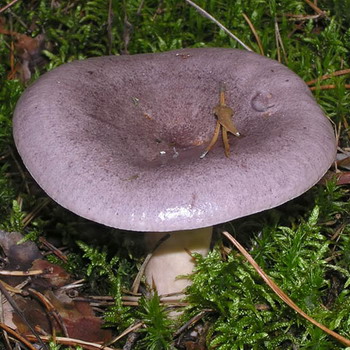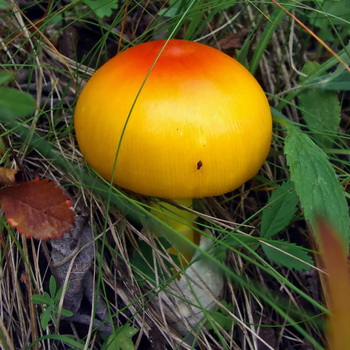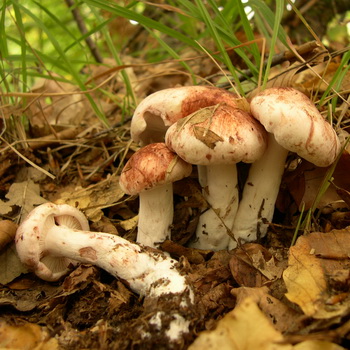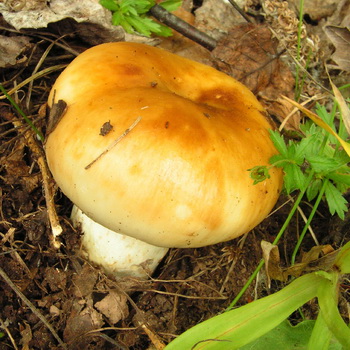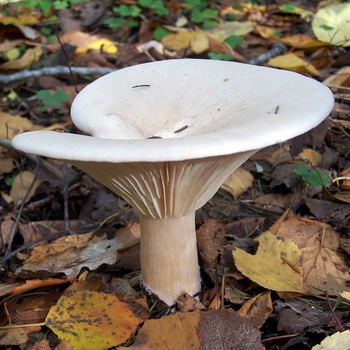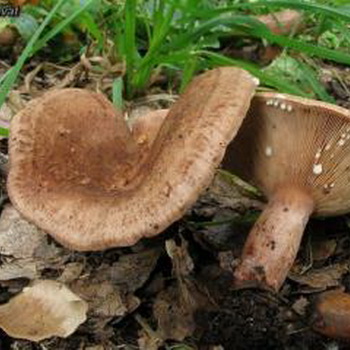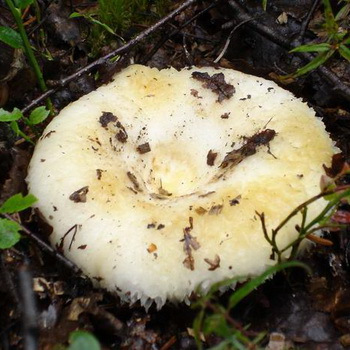Amanita edible: photo and description
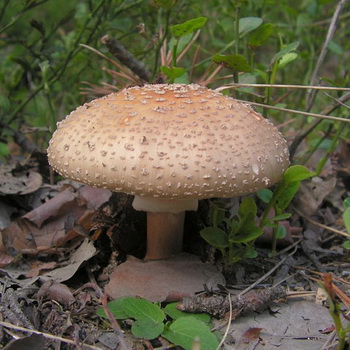
We bring to your attention photos of edible fly agarics: gray-pink (blushing, pink), orange, saffron and ovoid, a description of these mushrooms and information about their use in food.
Content
Edible fly agaric gray-pink (blushing, pink) and his photo
Category: conditionally edible.
Other names: Amanita muscaria, Amanita blushing.
Hat edible gray-pink fly agaric (Amanita rubescens) (diameter 7-22 cm) is usually pinkish, red or brown, in a young mushroom in the form of an egg without a tubercle characteristic of many fly agaric, it becomes slightly convex over time.
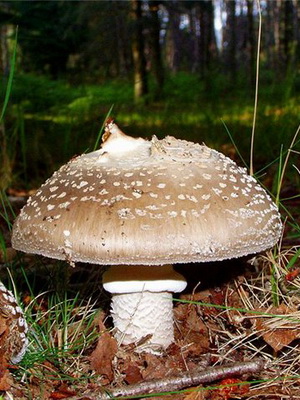
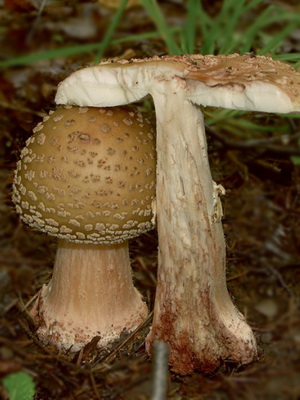
As can be seen in the photo of a gray-pink fly agaric, in adult mushrooms the hat is almost open, sticky to the touch.
Leg (height 4-12 cm): white or reddish, often with small tubercles. The young mushroom is solid, the old is completely hollow. Cylindrical with a slight thickening at the base.
Records: white, loose and wide. When pressed, they turn red.
The flesh of the pink edible fly agaric is very fleshy, white. At the place of the break, it is covered with red wormholes, and with prolonged interaction with air it becomes a saturated wine color. It does not have a pronounced taste and aroma.
Doubles of carnivorous fly agaric: panther (Amanita pantherina) and fat (Amanita spissa). Panther is extremely toxic, its flesh does not change color when damaged, there is a ring close to the base. The grayish flesh of a thick fly agaric also does not change color, moreover, this fungus has an unpleasant putrefactive odor.
When it grows: from mid-July until late autumn in temperate northern hemisphere countries.
Where can I find: in forests of any type and on any soil. Most often - next to birch and pine trees.
Eating: although it belongs to conditionally edible mushrooms, many mushroom pickers love the gray-pink fly agaric, because it appears in the forests very early. When cooking, preliminary heat treatment is necessary, after which the broth must be merged. In Europe, this mushroom is used in a salty form and is very appreciated.
Application in traditional medicine (data not confirmed and not passed clinical trials!): considered effective in the fight against diabetes and tuberculosis.
Important! In no case can the gray-pink fly agaric be eaten raw, since it contains a small amount of toxic substances that are not resistant to high temperatures.
Amanita mushroom saffron
Category: conditionally edible.
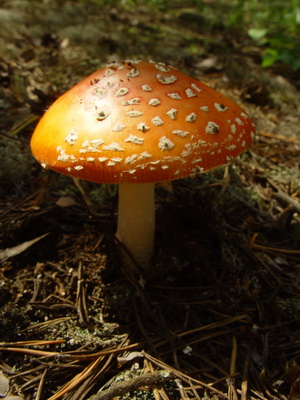
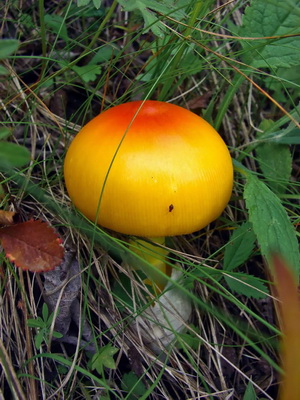
Hat saffron fly agaric (Amanita crocea) (diameter 4-14 cm) brilliant, orange or tan, has the shape of a bell, which over time changes to a more open. To the touch smooth, in wet weather, mucous. Edges with small grooves are often much lighter than a very fleshy center with a noticeable tubercle.
Leg (height 8-22 cm): hollow, brittle, white or light brown, has a cylindrical shape and tapers from the bottom up. Maybe with small scales.
Records: loose and frequent, white-gray or cream color.
Pulp: soft and thin, white, yellowish in old mushrooms. Breaks easily. It does not have a pronounced smell and taste.
Doubles: are absent.
When growing: from mid-July to the end of September in the temperate zone of the Eurasian continent and North America.
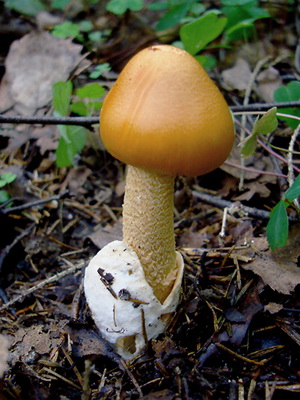
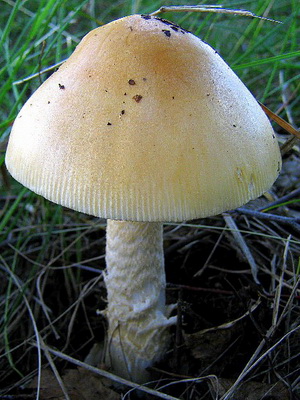
Where can I find: on fertile soils next to birch and oak.
Eating: although it refers to conditionally edible mushrooms, it can be used in any form, except for raw.
Application in traditional medicine: not applicable.
Important! Raw saffron fly agaric can cause mild poisoning, so before you taste it, it is better to boil it.
Edible fly agaric ovoid
Category: edible.
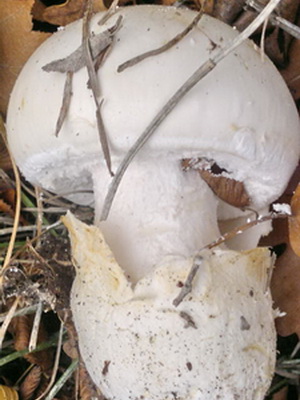
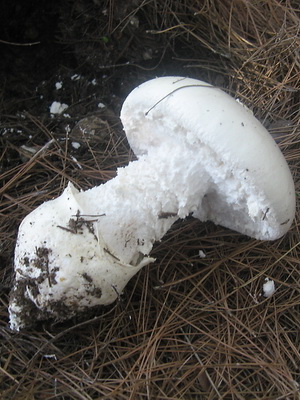
Hat ovoid fly agaric (Amanita ovoidea) (diameter 5-22 cm) whitish or dirty gray, often with the remains of the bedspread. In young mushrooms, it is covered with small whitish flakes and has the shape of a small chicken egg, spreads over time and becomes almost flat. The edges are even. Dry to the touch.
Leg (height 7-15 cm): the color usually coincides with a hat, dense, with a powdery coating. Visibly expanding at the base.
Records: loose, pubescent, with a cream tint.
Pulp: dense, white.
Doubles: close fly agaric (Amanita proxima), spring (Amanita verna) and smelly (Amanita virosa). But the poisonous near and spring ones have a ring on the stem, while the stinky fly agaric has a sticky hat, a pungent smell of chlorine and a ring on the stem of young mushrooms.
When growing: from early August to mid-October in the Far East and Siberia, in the Mediterranean, Switzerland, Ukraine, Austria, Georgia and Japan.

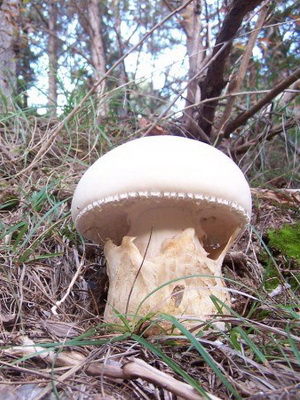
Where can I find: on calcareous soils of coniferous and deciduous forests, mainly in the vicinity of pine, oak and chestnut trees.
Eating: unlike most fly agarics, ovoid edible, very tasty and is used in any form.
Application in traditional medicine: not applicable.
Important! Since ovoid fly agaric mushrooms have a great resemblance to deadly counterparts, it is recommended to collect them only in the company of experienced mushroom pickers.
Amanita mushroom orange
Category: conditionally edible.

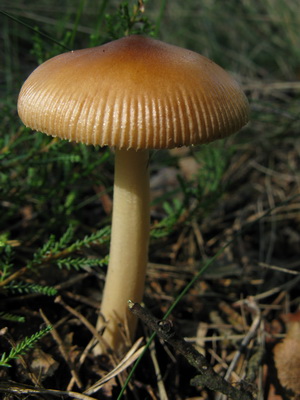
Hat orange fly agaric (Amanita fulva) (diameter 5-12 cm) golden-orange or orange-brown, bell-shaped or slightly prostrate. To the touch smooth, in wet weather or after rain, mucous. In the center there is a small tubercle, edges with grooves.
Leg (height 6-15 cm): hollow and very fragile, solid gray, occasionally with small scales. Narrows from bottom to top.
Records: loose, cream color.
Pulp: soft and watery, usually white in color, which does not change at the site of the cut. The smell is weak and the taste is very sweet.
Doubles: floats, but they, unlike the orange fly agaric, have a ring on their leg.
Application in traditional medicine: not applicable.
When growing: from mid-June to early October in many territories of the Eurasian continent (Turkmenistan, China, Sakhalin, Kamchatka, the entire Far Eastern District).
Important! If you want to taste the orange fly agaric, you must first boil it for at least 1520 minutes. Raw mushrooms can cause poisoning.
Where can I find: on acidic soils of mixed or coniferous forests, most often near birch trees. It can be found in the steppe zone and on swampy soils.
Other names: float yellow-brown, fly agaric yellow-brown, brown float, red-brown float.
Eating: It belongs to the conditionally edible group and is not particularly popular, since the mushroom has little pulp and it is very brittle.
